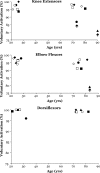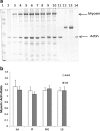Evolving concepts on the age-related changes in "muscle quality"
- PMID: 22476917
- PMCID: PMC3374023
- DOI: 10.1007/s13539-011-0054-2
Evolving concepts on the age-related changes in "muscle quality"
Abstract
The deterioration of skeletal muscle with advancing age has long been anecdotally recognized and has been of scientific interest for more than 150 years. Over the past several decades, the scientific and medical communities have recognized that skeletal muscle dysfunction (e.g., muscle weakness, poor muscle coordination, etc.) is a debilitating and life-threatening condition in the elderly. For example, the age-associated loss of muscle strength is highly associated with both mortality and physical disability. It is well-accepted that voluntary muscle force production is not solely dependent upon muscle size, but rather results from a combination of neurologic and skeletal muscle factors, and that biologic properties of both of these systems are altered with aging. Accordingly, numerous scientists and clinicians have used the term "muscle quality" to describe the relationship between voluntary muscle strength and muscle size. In this review article, we discuss the age-associated changes in the neuromuscular system-starting at the level of the brain and proceeding down to the subcellular level of individual muscle fibers-that are potentially influential in the etiology of dynapenia (age-related loss of muscle strength and power).
Figures





Similar articles
-
What is dynapenia?Nutrition. 2012 May;28(5):495-503. doi: 10.1016/j.nut.2011.12.002. Nutrition. 2012. PMID: 22469110 Free PMC article. Review.
-
Sarcopenia =/= dynapenia.J Gerontol A Biol Sci Med Sci. 2008 Aug;63(8):829-34. doi: 10.1093/gerona/63.8.829. J Gerontol A Biol Sci Med Sci. 2008. PMID: 18772470 Review.
-
Powerpenia Should be Considered a Biomarker of Healthy Aging.Sports Med Open. 2024 Mar 25;10(1):27. doi: 10.1186/s40798-024-00689-6. Sports Med Open. 2024. PMID: 38523229 Free PMC article.
-
Resistance Exercise to Prevent and Manage Sarcopenia and Dynapenia.Annu Rev Gerontol Geriatr. 2016;36(1):205-228. doi: 10.1891/0198-8794.36.205. Annu Rev Gerontol Geriatr. 2016. PMID: 27134329 Free PMC article.
-
Plasticity and function of human skeletal muscle in relation to disuse and rehabilitation: Influence of ageing and surgery.Dan Med J. 2017 Aug;64(8):B5377. Dan Med J. 2017. PMID: 28869034
Cited by
-
Age-induced oxidative stress: how does it influence skeletal muscle quantity and quality?J Appl Physiol (1985). 2016 Nov 1;121(5):1047-1052. doi: 10.1152/japplphysiol.00321.2016. Epub 2016 May 19. J Appl Physiol (1985). 2016. PMID: 27197856 Free PMC article. Review.
-
Operational definitions of sarcopenia and their associations with 5-year changes in falls risk in community-dwelling middle-aged and older adults.Osteoporos Int. 2014 Jan;25(1):187-93. doi: 10.1007/s00198-013-2431-5. Epub 2013 Jun 26. Osteoporos Int. 2014. PMID: 23800748
-
The role of neuromuscular changes in aging and knee osteoarthritis on dynamic postural control.Aging Dis. 2013 Jan 15;4(2):84-99. Print 2013 Apr. Aging Dis. 2013. PMID: 23696951 Free PMC article.
-
Single skeletal muscle fiber mechanical properties: a muscle quality biomarker of human aging.Eur J Appl Physiol. 2022 Jun;122(6):1383-1395. doi: 10.1007/s00421-022-04924-4. Epub 2022 Mar 6. Eur J Appl Physiol. 2022. PMID: 35249139 Review.
-
Dietary fish oil supplement induces age-specific contractile and proteomic responses in muscles of male rats.Lipids Health Dis. 2020 Jul 9;19(1):165. doi: 10.1186/s12944-020-01333-4. Lipids Health Dis. 2020. PMID: 32646455 Free PMC article.
References
-
- Federal Interagency Forum on Aging-Related Statistics . Older Americans 2008: key indicators of well-being. Washington: U.S. Government Printing Office; 2008.
Grants and funding
LinkOut - more resources
Full Text Sources
Miscellaneous

